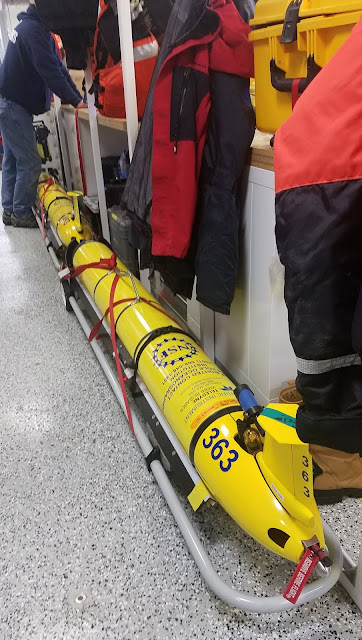With four official CTD casts now under our belt, the Biological Carbon Pump Team (BCP
Team) is feeling much more confident in our sampling and sample processing
abilities. We have worked on establishing a system for pre-cast preparations,
sampling procedures while the CTD is on deck, and post-cast sample processing.
Before each cast, we gather and label the necessary bottles for each depth that
we want to sample.
Sensors on the CTD show us a profile of factors like dissolved oxygen, salinity, and temperature as it descends. We pay special attention to changes in the concentration of dissolved oxygen along the profile, because this variable is particularly important for our research. Changes in dissolved oxygen may indicate whether the water at these depths was previously in contact with the atmosphere. Air exchange at the ocean surface and mixing of surface water with deeper water contribute to the formation of a mixed layer visible in the profiles provided by the CTD. We try to identify the present boundary of this mixed layer as the CTD descends, and sometimes we can infer depths that the mixed layer reached in past seasons. We then take samples from these depths as part of the CTD cast.
Sensors on the CTD show us a profile of factors like dissolved oxygen, salinity, and temperature as it descends. We pay special attention to changes in the concentration of dissolved oxygen along the profile, because this variable is particularly important for our research. Changes in dissolved oxygen may indicate whether the water at these depths was previously in contact with the atmosphere. Air exchange at the ocean surface and mixing of surface water with deeper water contribute to the formation of a mixed layer visible in the profiles provided by the CTD. We try to identify the present boundary of this mixed layer as the CTD descends, and sometimes we can infer depths that the mixed layer reached in past seasons. We then take samples from these depths as part of the CTD cast.
Dissolved
oxygen concentrations also change over the seasons due to biology. Phytoplankton are small, floating organisms which produce oxygen as they photosynthesize. During the warmer and sunnier months, phytoplankton in the Irminger Sea undergo a spring blooming period. This increases the dissolved
oxygen saturation in the upper depths of the ocean. We are arriving at the tail end of this spring bloom, so our measurements will hopefully reflect interesting patterns telling us about the productivity of these phytoplankton and the changing dissolved oxygen saturation as they die off and/or are eaten by larger marine organisms.
We are also
able to study dissolved oxygen levels using gliders, pictured below, which are
autonomous underwater vehicles that look like mini yellow submarines. On
Sunday, the OOI team released two gliders to swim between the stationary moorings of the
Irminger Sea array. As part
of Hilary’s NSF-funded project, the oxygen sensors on both gliders were moved from the underside of the glider to the top. This allows them to periodically check the oxygen concentrations in the air to compare with measurements of dissolved oxygen in the ocean. The goal of these modifications is to better calibrate the oxygen sensors not only on the gliders but also the stationary oxygen sensors in
the Irminger Sea array, because each glider will be swimming between each of the moorings over the course of the year. Watching the deployment of the gliders was very
exciting!
 |
| These are the gliders pre-deployment. The oxygen sensor is the small black piece with blue masking tape mounted by the fin at the end. Neither glider has its wings installed in the photo. |
Collin Dobson,
the glider pilot on board to oversee the glider deployment, told us more about
how gliders navigate and function. Each glider is equipped with a fin and wings
which direct its flight through the water. A pitch battery inside the glider
slides about an inch forward and backward, guiding the angle of the dive. Each
time that the glider surfaces, it communicates data back to WHOI and checks its
GPS position to determine how it will navigate to its next point. I think it’s
amazing that while underwater, the glider relies completely on its past GPS
point to get to the next position, as it cannot determine its exact position
underwater.
 |
| This is Collin with the two gliders that we later deployed to swim around the Irminger Sea. He is a glider pilot with WHOI who enjoys giving unofficial names to his deployed gliders. |
Cheers,
Emma

Emma, that is profound: the glider must continue on its course between surfacings. It gives the device a kind of personality of determination, no?
ReplyDelete-Mit,
Littleton, Mass.